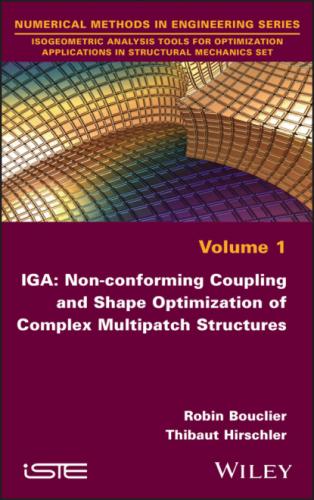[1.1]
where
[1.2]
Figure 1.1. Two simple planar curves
Parameter ξ1 takes any real value to represent the complete line or is bounded to represent a segment of the line. Using the same idea, the curve of the circle can be parameterized as follows:
[1.3]
Note that at this stage the parameterization is not unique and parametric forms are obviously not the only way of representing curves. Implicit equations are also commonly used to describe curves. For example, the circle of radius R and centered at the origin can be described by:
[1.4]
Both techniques have different advantages. The parametric form gives a direct way to compute a point on a curve. On the other hand, with the implicit form, it is easy to determine if a given point is on the curve or not.
The previous concept can be straightforwardly extended to multivariate geometric entities living in 2D or 3D physical spaces. There exist typical examples like those represented in Figure 1.2. For example, the unit surface sphere can be parameterized as:
[1.5]
with:
[1.6]
Two parameters are needed to describe a surface (θ and ϕ for the sphere). For describing a volume, three parameters are required. For example, the hollow cylinder from Figure 1.2 is described by:
[1.7]
with
[1.8]
NOTE.– Finally, note that the direct description of geometric entities in the parametric form may not be possible when these differ topologically from a square or a cube. In this case, Boolean operations between different parametric entities may be required to intersect and/or join them. We will see that this issue is reflected in IGA: it leads to facing non-conforming multipatch analysis, which is one of the current important challenges in the field and is largely addressed in this book.
Figure 1.2. Two simple (surface and volume) geometric objects
1.2.2. B-spline and NURBS technologies
The B-spline and NURBS families are the spline technologies that have become the standard for geometric modeling in CAD and computer graphics (Cohen et al. 1980, 2001; Piegl and Tiller 1997; Rogers 2000; Farin 2002) over the years. The NURBS functions lend themselves to an exact representation of many shapes used in engineering, such as conical sections (circles, cylinders, spheres, ellipsoids, etc.). NURBS are a generalization of B-splines: they can be viewed as rational projections of B-splines that are piecewise polynomials. Therefore, they possess many of the properties of B-splines, the most interesting one being their possible increased smoothness, thus implying models with few degrees of freedom. Since NURBS are based on B-splines, we start the presentation below with B-splines.
1.2.2.1. B-spline curves
The B-spline technology enables us to describe geometric entities in terms of smooth piecewise polynomials (Gordon and Riesenfeld 1974; Piegl and Tiller 1997). First, taking the univariate case, it expresses curves in the parametric form as:
where Pi is the control point associated with the univariate pth-degree B-spline basis function
[1.10]
where the interior knots verify the conditions
